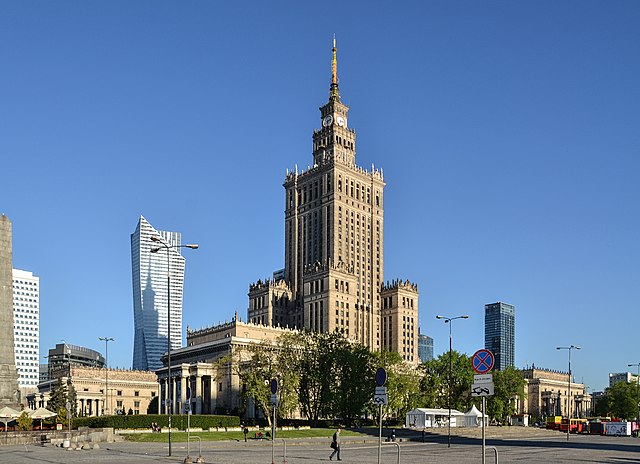Top Qs
Timeline
Chat
Perspective
1955 in architecture
From Wikipedia, the free encyclopedia
Remove ads
The year 1955 in architecture involved some significant architectural events and new buildings.
Events
- June – Outrage, a special issue of Architectural Review condemning the areas of British cities failed by urban planning, establishes the reputation of Ian Nairn as an architectural critic.
- December – Reyner Banham introduces the term "New Brutalism" into English print, writing in Architectural Review.
- Chinese American architect I. M. Pei establishes the architectural practice I. M. Pei & Associates with Eason H. Leonard and Henry N. Cobb in New York City.
- German architect Josef Bieling establishes the architectural practice Architekturbüro Josef Bieling in his hometown Kassel.
Remove ads
Buildings and structures



Buildings opened
- June 25 – Notre Dame du Haut in Ronchamp, France, designed by Le Corbusier, is dedicated.[1]
- July 22 – Palace of Culture and Science in Warsaw, the tallest building in Poland (1955–present) and the second tallest in Europe (1955–1990), designed by Lev Rudnev.[1]
- August – Hiroshima Peace Memorial Museum, Japan, designed by Kenzō Tange.
Buildings completed
- February – Bavinger House in Norman, Oklahoma, United States, the best-known building designed by Bruce Goff.[2][3]
- MIT Chapel and Kresge Auditorium at Massachusetts Institute of Technology, Cambridge, Massachusetts, designed by Eero Saarinen.[1]
- Chapel of Trinity College, Toronto, designed by Giles Gilbert Scott.
- Dominus Flevit Church, Jerusalem, designed by Antonio Barluzzi.
- Restoration following bomb damage at Lambeth Palace in London, by Seely & Paget.[4]
- Reconstructed Kinkaku-ji temple in Kyoto, Japan.
- Chandigarh High Court (Palace of Justice), Chandigarh Capitol Complex, India, designed by Le Corbusier.[1]
- Southern Alberta Jubilee Auditorium in Calgary, Alberta.
- Northern Alberta Jubilee Auditorium in Edmonton, Alberta.
- Punta La Entallada Lighthouse on Fuerteventura, Canary Islands, designed by Carlos Alcon.
- Fundació Pilar y Joan Miró in Palma, Majorca, designed by Josep Lluís Sert.
- Tate & Lyle sugar silo, Liverpool, England.[1]
- Casa Antonio Gálvez, Mexico City, designed by Luis Barragán.[1]
- House Fox, Worcester, Western Cape, South Africa, designed by Revel Fox.[1]
- Houses for self at 7 Gibraltar Hill and for E. W. Scorer, both in Lincoln, England, designed by Sam Scorer.
- House for John Womersley at Farnley Tyas, Yorkshire, England, designed by Peter Womersley.
- "Hermit's Castle", Achmelvich, Scotland, designed by David Scott.[5]
Remove ads
Awards
- AIA Gold Medal – Willem Marinus Dudok.
- RIBA Royal Gold Medal – John Murray Easton.
- Grand Prix de Rome, architecture – Ngô Viết Thụ.
Births
- February 12 – Enric Miralles, Spanish Catalan architect (died 2000)
- April 14 – Robert Couturier, French architect and interior designer, designer of Cuixmala[6]
- July 2 – Francine Houben, Dutch architect
- August 2 – Anne Lacaton, French architect
- November 17 – Amanda Levete, British architect
- date unknown
- Miroslav Grčev, Macedonian architect and graphic designer
- Alan Powers, British modern architecture and design historian
Remove ads
Deaths
- February 7 – Carl Rubin, Galician-born Israeli International Style architect (born 1899)
- April 16 – George Howe, American International Style architect and educator (born 1886)
- August 6 – Dominikus Böhm, German church architect (born 1880)
- November 29 – Rene Paul Chambellan, American architectural sculptor (born 1893)
References
Wikiwand - on
Seamless Wikipedia browsing. On steroids.
Remove ads